
All categories


How to scale a business? It’s a question every entrepreneur hopes to ask at some stage. Because scaling a business puts processes in place to support sustainable, long-term growth. And what business owner doesn’t want that?
You might relate to the following scenario:
You've been working on your business for quite some time. You have a decent run rate, a significant pipeline, and ambitious growth plans. But still, you're struggling every day to scale up.
The start of the scenario looks like you’re primed to grow your business - which is great! But growing your business and scaling your business are different.
Your business growth can skyrocket, even without scaling processes. This can lead to problems later if the expansion is built on shaky, hard-to-scale foundations.
Scaleup isn't just about proving your business model, finding a product-market fit in the new world order, or increasing revenues. Scaling your business is about streamlining your processes to ensure everything is ready for replication (and sustainable growth).
You must increase your productivity with the same (or less) input to scale a business. A scalable business model has:
Underlying profitability
Automation to boost productivity
Strong lead generation and sales processes
Discover how to scale your business with these steps for a solid foundation.
Scale a Business in 5 Steps
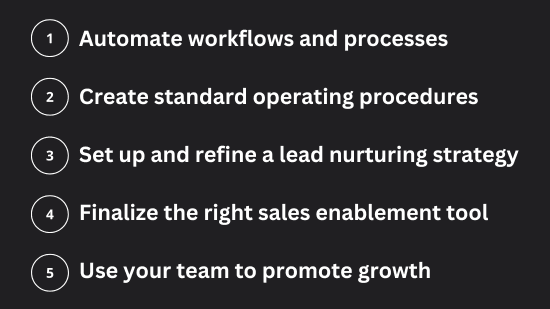
1. Automate workflows and processes
Automation is setting up rules and flows to make things happen. In the simplest terms, automation is when machines or computers do tasks automatically without you having to do them manually.
Automation is the entrepreneur's best friend. Using the right automation tactics is like having an army of minions working around the clock to help scale your business.
Think about it this way: You don't have to waste time on mundane activities like sending emails manually about project updates, posting on social media every day, or onboarding clients.
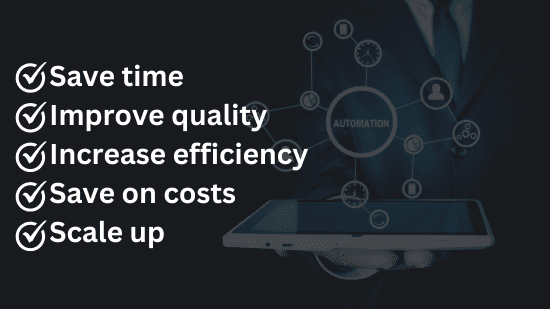
Automation helps you:
Save time - Completes tasks faster, freeing up time for employees to focus on more complex or creative aspects of their work, leading to more innovation.
Improve quality - Maintains consistent quality standards by minimizing error and variability in service delivery.
Increase efficiency - Performs tasks faster and more accurately for higher productivity and efficiency in various processes.
Save on costs - Reduces labor costs over time and the need for physical resources to save you money.
Scale up - Boosts business scope to meet changing demands without significantly increasing costs or resources.
Say you run a photography business. You’re quoting jobs manually, draining your time and causing you stress. Automating processes saves you time, eases your anxiety, and helps you scale your business.
You can set up a price quote calculator on your website - let customers get instant pricing. This works for you 24/7 and lets you focus on other areas of your business.
Rift Photography cut 6 hours of their quoting time and saw a 25% boost in conversions using our quoting tool.
Some other powerful automation tools are:
Zapier - Connects multiple apps to create automation sequences. For example, it can automatically save form submission data to your CRM for follow-up.
SuiteDash - Helps you set up powerful automation sequences to simplify client onboarding, speed up project management, and more.
Encharge - Tracks page visits and form submissions on your website in real time.
2. Create standard operating procedures
Creating standard operating procedures (SOPs) for general business activities is necessary to scale your business. Otherwise, how do you ensure your team follows the ''right way'' of doing things? Or how do you set automation funnels/tools in place?
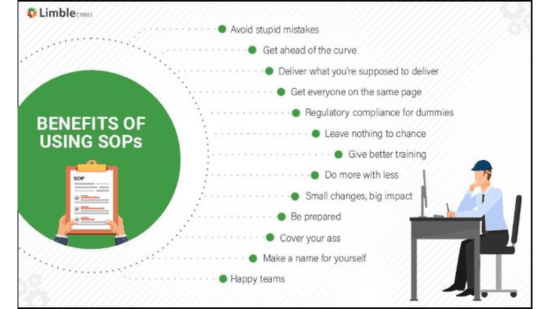
SOPs bring standardization and help you concentrate on opportunities to scale your business. If you're serious about taking your company to the next level, documenting your business processes is something you should practice religiously.
Take content marketing, for example. How do you do your keyword research? Which tools do you use? What happens right after you are done researching keywords?
Business processes can get messy without SOPs.
Every process in your business can have a dedicated SOP. But create SOPs based on your preferences, growth goals, and team capabilities.
A general best practice to start creating SOPs is to make them based on industry best practices and your success metrics. For instance, there are many ways to market your business, but you should make an SOP based on your goals and sound marketing best practices and habits.
3. Set up and refine a lead nurturing strategy
You need a lead nurturing strategy if you want to scale your business. Lead nurturing is forming and maintaining relationships with your potential and existing customers.
There are 5 types of leads:
Unqualified leads - These leads are cold, and you haven’t nurtured them enough to try to sell to them.
Marketing qualified leads - They’ve shown interest in your marketing, maybe completing a quiz on your website, but need more nurturing.
Sales qualified leads - These leads are warm and have shown buying interest.
Product qualified leads - They’ve shown interest in a specific product like starting a free trial.
Service qualified leads - Have interacted with your services and communicated their interest in becoming paying customers.
The purpose of lead nurturing is to guide potential customers through the buying journey. You want to steer them from unqualified leads (Arctic cold) to paying customers (Sahara hot).
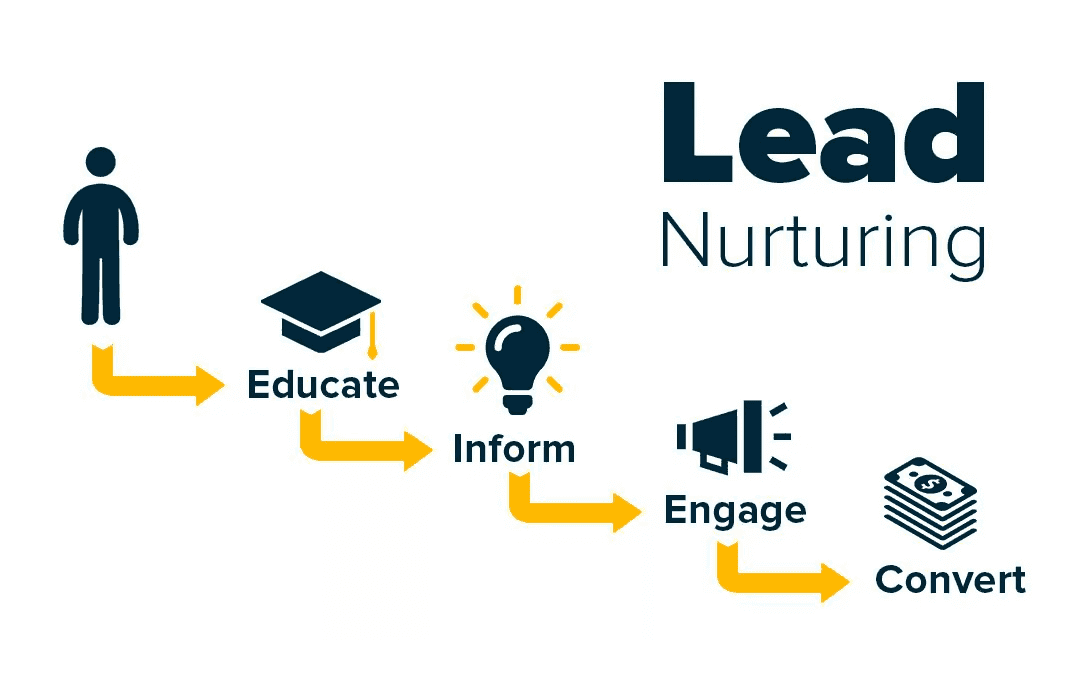
According to industry data, 96% of your website visitors aren’t ready to buy. That’s a large percentage of people for you to start nurturing along the buyer’s journey.
They’re not ready to buy yet, but they might be open to sharing their personal information for valuable content. You can move all those visitors further into your marketing funnel by setting up a lead nurture campaign.
Let’s run through a scenario:
A potential lead lands on your website from Google search - thanks to your SEO efforts.
You have an interactive calculator on your homepage - people love engaging with interactive content like this.
The calculator offers your potential lead valuable information, so they start using it.
They input data and exchange their contact details for personalized instant results.
You get a new lead to nurture alone the buying journey.
Send them personalized emails and monthly newsletters.
Keep engaging them with follow-up campaigns and interesting offers.
You can start collecting leads from the day you launch your website and use the available data to scale your business. Setting up exciting tests and forms can also be an excellent boost for your lead nurturing strategy.
View your analytics and refine your strategy for a solid foundation when scaling your business.
Our essential guide to lead qualification covers more about qualifying leads during the nurturing process.
4. Finalize the right sales enablement tool
Sales enablement means equipping your sales team with the resources to help them do a better job and close more deals. This can involve sharing:
Information
Expertise
Content
Tools
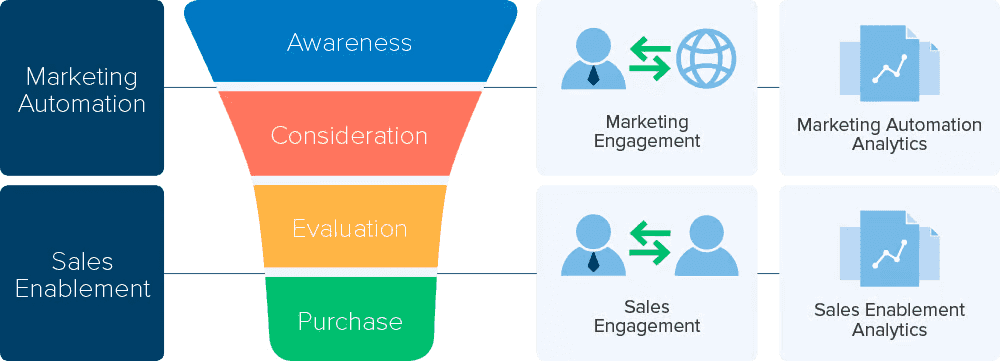
You may rely on Google Drive or multiple standalone tools now. But you need an intelligent and robust sales enablement tool if you want to scale your business.
According to G2, an organization with sales enablement capabilities registers a 49% win rate against 42.5% in organizations without sales enablement abilities. Sales enablement isn't only about having some tool/feature in your workflow.
Encouraging a sales enablement mindset is like equipping your sales force with the best tool for the job so they don't waste time.
Industry data show:
Most sales personnel spend 440 hours every year trying to find the right content to share with prospects.
On average, companies lose $2.3 million annually on opportunity costs related to unused marketing content.
How much value could the best sales enablement tool add to your scalability initiatives? Scaling your business is easier when your sales team has everything it needs to work efficiently.
Picking the right sales enablement solution is like choosing the best tool for any job. You won’t see a gold digger stabbing at the ground with a pen - that’s a soon-to-be penniless gold digger.
The sooner you start using the best tool, the faster you’ll strike gold with sales enablement.
5. Use your team to promote growth
Once you have established strong foundations for scaling your business, you can focus on promoting business growth. Because the bedrock of your business is solid and processes are in place for sustainable expansion.

Focusing on employer branding initiatives and using your team effectively is a fantastic (and cost-effective) way to grow your business.
How can employer branding help you scale?
Take a second and look all around you. Everyone's busy promoting their company culture online. SaaS founders (and their teams) post photos of company retreats, welcome boxes, and similar things on their social feeds.
Using your existing investment in building a team can be a sneaky-good tactic for promoting growth. Your employees can spread awareness about your brand and help you expand your audience.
But be careful with this approach. For instance, you shouldn't force your employees to post good things on LinkedIn. Promoting growth for your business should be organic instead of manufactured.
You can organically attract good media (and an amazingly efficient team) if you encourage a user-generated content (UGC) engine around your company. Chances are this will bring business your way through the network effect.
Making your team part of the journey helps you expand your horizons. You can plan for guest features on popular websites, contact influencers, and approach podcasters in your niche to increase your reach.
This channel for scaling your business kickstarts an organic engine for sustainable growth. Kind of like word-of-mouth in the pre-internet era. And we all love organic publicity, right?
Conclusion
These 5 steps will get you started in figuring out how to scale your business. Remember, it’s not about loading the engine with fuel and striking the match to blast your growth to another dimension.
Scaling a business is about having the processes in place for sustainable growth. So when your business does start exploding, you can expand without running into any problems and hitting a ceiling.
Scaling means doing more with the same (or less) input than before. The best business scaling is like getting more juice with less squeeze.
Choosing the right tools to reach your goals is part of creating a solid foundation. We can help you with that at Convert.
Happy scaling!
How to scale a business? It’s a question every entrepreneur hopes to ask at some stage. Because scaling a business puts processes in place to support sustainable, long-term growth. And what business owner doesn’t want that?
You might relate to the following scenario:
You've been working on your business for quite some time. You have a decent run rate, a significant pipeline, and ambitious growth plans. But still, you're struggling every day to scale up.
The start of the scenario looks like you’re primed to grow your business - which is great! But growing your business and scaling your business are different.
Your business growth can skyrocket, even without scaling processes. This can lead to problems later if the expansion is built on shaky, hard-to-scale foundations.
Scaleup isn't just about proving your business model, finding a product-market fit in the new world order, or increasing revenues. Scaling your business is about streamlining your processes to ensure everything is ready for replication (and sustainable growth).
You must increase your productivity with the same (or less) input to scale a business. A scalable business model has:
Underlying profitability
Automation to boost productivity
Strong lead generation and sales processes
Discover how to scale your business with these steps for a solid foundation.
Scale a Business in 5 Steps

1. Automate workflows and processes
Automation is setting up rules and flows to make things happen. In the simplest terms, automation is when machines or computers do tasks automatically without you having to do them manually.
Automation is the entrepreneur's best friend. Using the right automation tactics is like having an army of minions working around the clock to help scale your business.
Think about it this way: You don't have to waste time on mundane activities like sending emails manually about project updates, posting on social media every day, or onboarding clients.

Automation helps you:
Save time - Completes tasks faster, freeing up time for employees to focus on more complex or creative aspects of their work, leading to more innovation.
Improve quality - Maintains consistent quality standards by minimizing error and variability in service delivery.
Increase efficiency - Performs tasks faster and more accurately for higher productivity and efficiency in various processes.
Save on costs - Reduces labor costs over time and the need for physical resources to save you money.
Scale up - Boosts business scope to meet changing demands without significantly increasing costs or resources.
Say you run a photography business. You’re quoting jobs manually, draining your time and causing you stress. Automating processes saves you time, eases your anxiety, and helps you scale your business.
You can set up a price quote calculator on your website - let customers get instant pricing. This works for you 24/7 and lets you focus on other areas of your business.
Rift Photography cut 6 hours of their quoting time and saw a 25% boost in conversions using our quoting tool.
Some other powerful automation tools are:
Zapier - Connects multiple apps to create automation sequences. For example, it can automatically save form submission data to your CRM for follow-up.
SuiteDash - Helps you set up powerful automation sequences to simplify client onboarding, speed up project management, and more.
Encharge - Tracks page visits and form submissions on your website in real time.
2. Create standard operating procedures
Creating standard operating procedures (SOPs) for general business activities is necessary to scale your business. Otherwise, how do you ensure your team follows the ''right way'' of doing things? Or how do you set automation funnels/tools in place?

SOPs bring standardization and help you concentrate on opportunities to scale your business. If you're serious about taking your company to the next level, documenting your business processes is something you should practice religiously.
Take content marketing, for example. How do you do your keyword research? Which tools do you use? What happens right after you are done researching keywords?
Business processes can get messy without SOPs.
Every process in your business can have a dedicated SOP. But create SOPs based on your preferences, growth goals, and team capabilities.
A general best practice to start creating SOPs is to make them based on industry best practices and your success metrics. For instance, there are many ways to market your business, but you should make an SOP based on your goals and sound marketing best practices and habits.
3. Set up and refine a lead nurturing strategy
You need a lead nurturing strategy if you want to scale your business. Lead nurturing is forming and maintaining relationships with your potential and existing customers.
There are 5 types of leads:
Unqualified leads - These leads are cold, and you haven’t nurtured them enough to try to sell to them.
Marketing qualified leads - They’ve shown interest in your marketing, maybe completing a quiz on your website, but need more nurturing.
Sales qualified leads - These leads are warm and have shown buying interest.
Product qualified leads - They’ve shown interest in a specific product like starting a free trial.
Service qualified leads - Have interacted with your services and communicated their interest in becoming paying customers.
The purpose of lead nurturing is to guide potential customers through the buying journey. You want to steer them from unqualified leads (Arctic cold) to paying customers (Sahara hot).

According to industry data, 96% of your website visitors aren’t ready to buy. That’s a large percentage of people for you to start nurturing along the buyer’s journey.
They’re not ready to buy yet, but they might be open to sharing their personal information for valuable content. You can move all those visitors further into your marketing funnel by setting up a lead nurture campaign.
Let’s run through a scenario:
A potential lead lands on your website from Google search - thanks to your SEO efforts.
You have an interactive calculator on your homepage - people love engaging with interactive content like this.
The calculator offers your potential lead valuable information, so they start using it.
They input data and exchange their contact details for personalized instant results.
You get a new lead to nurture alone the buying journey.
Send them personalized emails and monthly newsletters.
Keep engaging them with follow-up campaigns and interesting offers.
You can start collecting leads from the day you launch your website and use the available data to scale your business. Setting up exciting tests and forms can also be an excellent boost for your lead nurturing strategy.
View your analytics and refine your strategy for a solid foundation when scaling your business.
Our essential guide to lead qualification covers more about qualifying leads during the nurturing process.
4. Finalize the right sales enablement tool
Sales enablement means equipping your sales team with the resources to help them do a better job and close more deals. This can involve sharing:
Information
Expertise
Content
Tools

You may rely on Google Drive or multiple standalone tools now. But you need an intelligent and robust sales enablement tool if you want to scale your business.
According to G2, an organization with sales enablement capabilities registers a 49% win rate against 42.5% in organizations without sales enablement abilities. Sales enablement isn't only about having some tool/feature in your workflow.
Encouraging a sales enablement mindset is like equipping your sales force with the best tool for the job so they don't waste time.
Industry data show:
Most sales personnel spend 440 hours every year trying to find the right content to share with prospects.
On average, companies lose $2.3 million annually on opportunity costs related to unused marketing content.
How much value could the best sales enablement tool add to your scalability initiatives? Scaling your business is easier when your sales team has everything it needs to work efficiently.
Picking the right sales enablement solution is like choosing the best tool for any job. You won’t see a gold digger stabbing at the ground with a pen - that’s a soon-to-be penniless gold digger.
The sooner you start using the best tool, the faster you’ll strike gold with sales enablement.
5. Use your team to promote growth
Once you have established strong foundations for scaling your business, you can focus on promoting business growth. Because the bedrock of your business is solid and processes are in place for sustainable expansion.

Focusing on employer branding initiatives and using your team effectively is a fantastic (and cost-effective) way to grow your business.
How can employer branding help you scale?
Take a second and look all around you. Everyone's busy promoting their company culture online. SaaS founders (and their teams) post photos of company retreats, welcome boxes, and similar things on their social feeds.
Using your existing investment in building a team can be a sneaky-good tactic for promoting growth. Your employees can spread awareness about your brand and help you expand your audience.
But be careful with this approach. For instance, you shouldn't force your employees to post good things on LinkedIn. Promoting growth for your business should be organic instead of manufactured.
You can organically attract good media (and an amazingly efficient team) if you encourage a user-generated content (UGC) engine around your company. Chances are this will bring business your way through the network effect.
Making your team part of the journey helps you expand your horizons. You can plan for guest features on popular websites, contact influencers, and approach podcasters in your niche to increase your reach.
This channel for scaling your business kickstarts an organic engine for sustainable growth. Kind of like word-of-mouth in the pre-internet era. And we all love organic publicity, right?
Conclusion
These 5 steps will get you started in figuring out how to scale your business. Remember, it’s not about loading the engine with fuel and striking the match to blast your growth to another dimension.
Scaling a business is about having the processes in place for sustainable growth. So when your business does start exploding, you can expand without running into any problems and hitting a ceiling.
Scaling means doing more with the same (or less) input than before. The best business scaling is like getting more juice with less squeeze.
Choosing the right tools to reach your goals is part of creating a solid foundation. We can help you with that at Convert.
Happy scaling!
How to scale a business? It’s a question every entrepreneur hopes to ask at some stage. Because scaling a business puts processes in place to support sustainable, long-term growth. And what business owner doesn’t want that?
You might relate to the following scenario:
You've been working on your business for quite some time. You have a decent run rate, a significant pipeline, and ambitious growth plans. But still, you're struggling every day to scale up.
The start of the scenario looks like you’re primed to grow your business - which is great! But growing your business and scaling your business are different.
Your business growth can skyrocket, even without scaling processes. This can lead to problems later if the expansion is built on shaky, hard-to-scale foundations.
Scaleup isn't just about proving your business model, finding a product-market fit in the new world order, or increasing revenues. Scaling your business is about streamlining your processes to ensure everything is ready for replication (and sustainable growth).
You must increase your productivity with the same (or less) input to scale a business. A scalable business model has:
Underlying profitability
Automation to boost productivity
Strong lead generation and sales processes
Discover how to scale your business with these steps for a solid foundation.
Scale a Business in 5 Steps

1. Automate workflows and processes
Automation is setting up rules and flows to make things happen. In the simplest terms, automation is when machines or computers do tasks automatically without you having to do them manually.
Automation is the entrepreneur's best friend. Using the right automation tactics is like having an army of minions working around the clock to help scale your business.
Think about it this way: You don't have to waste time on mundane activities like sending emails manually about project updates, posting on social media every day, or onboarding clients.

Automation helps you:
Save time - Completes tasks faster, freeing up time for employees to focus on more complex or creative aspects of their work, leading to more innovation.
Improve quality - Maintains consistent quality standards by minimizing error and variability in service delivery.
Increase efficiency - Performs tasks faster and more accurately for higher productivity and efficiency in various processes.
Save on costs - Reduces labor costs over time and the need for physical resources to save you money.
Scale up - Boosts business scope to meet changing demands without significantly increasing costs or resources.
Say you run a photography business. You’re quoting jobs manually, draining your time and causing you stress. Automating processes saves you time, eases your anxiety, and helps you scale your business.
You can set up a price quote calculator on your website - let customers get instant pricing. This works for you 24/7 and lets you focus on other areas of your business.
Rift Photography cut 6 hours of their quoting time and saw a 25% boost in conversions using our quoting tool.
Some other powerful automation tools are:
Zapier - Connects multiple apps to create automation sequences. For example, it can automatically save form submission data to your CRM for follow-up.
SuiteDash - Helps you set up powerful automation sequences to simplify client onboarding, speed up project management, and more.
Encharge - Tracks page visits and form submissions on your website in real time.
2. Create standard operating procedures
Creating standard operating procedures (SOPs) for general business activities is necessary to scale your business. Otherwise, how do you ensure your team follows the ''right way'' of doing things? Or how do you set automation funnels/tools in place?

SOPs bring standardization and help you concentrate on opportunities to scale your business. If you're serious about taking your company to the next level, documenting your business processes is something you should practice religiously.
Take content marketing, for example. How do you do your keyword research? Which tools do you use? What happens right after you are done researching keywords?
Business processes can get messy without SOPs.
Every process in your business can have a dedicated SOP. But create SOPs based on your preferences, growth goals, and team capabilities.
A general best practice to start creating SOPs is to make them based on industry best practices and your success metrics. For instance, there are many ways to market your business, but you should make an SOP based on your goals and sound marketing best practices and habits.
3. Set up and refine a lead nurturing strategy
You need a lead nurturing strategy if you want to scale your business. Lead nurturing is forming and maintaining relationships with your potential and existing customers.
There are 5 types of leads:
Unqualified leads - These leads are cold, and you haven’t nurtured them enough to try to sell to them.
Marketing qualified leads - They’ve shown interest in your marketing, maybe completing a quiz on your website, but need more nurturing.
Sales qualified leads - These leads are warm and have shown buying interest.
Product qualified leads - They’ve shown interest in a specific product like starting a free trial.
Service qualified leads - Have interacted with your services and communicated their interest in becoming paying customers.
The purpose of lead nurturing is to guide potential customers through the buying journey. You want to steer them from unqualified leads (Arctic cold) to paying customers (Sahara hot).

According to industry data, 96% of your website visitors aren’t ready to buy. That’s a large percentage of people for you to start nurturing along the buyer’s journey.
They’re not ready to buy yet, but they might be open to sharing their personal information for valuable content. You can move all those visitors further into your marketing funnel by setting up a lead nurture campaign.
Let’s run through a scenario:
A potential lead lands on your website from Google search - thanks to your SEO efforts.
You have an interactive calculator on your homepage - people love engaging with interactive content like this.
The calculator offers your potential lead valuable information, so they start using it.
They input data and exchange their contact details for personalized instant results.
You get a new lead to nurture alone the buying journey.
Send them personalized emails and monthly newsletters.
Keep engaging them with follow-up campaigns and interesting offers.
You can start collecting leads from the day you launch your website and use the available data to scale your business. Setting up exciting tests and forms can also be an excellent boost for your lead nurturing strategy.
View your analytics and refine your strategy for a solid foundation when scaling your business.
Our essential guide to lead qualification covers more about qualifying leads during the nurturing process.
4. Finalize the right sales enablement tool
Sales enablement means equipping your sales team with the resources to help them do a better job and close more deals. This can involve sharing:
Information
Expertise
Content
Tools

You may rely on Google Drive or multiple standalone tools now. But you need an intelligent and robust sales enablement tool if you want to scale your business.
According to G2, an organization with sales enablement capabilities registers a 49% win rate against 42.5% in organizations without sales enablement abilities. Sales enablement isn't only about having some tool/feature in your workflow.
Encouraging a sales enablement mindset is like equipping your sales force with the best tool for the job so they don't waste time.
Industry data show:
Most sales personnel spend 440 hours every year trying to find the right content to share with prospects.
On average, companies lose $2.3 million annually on opportunity costs related to unused marketing content.
How much value could the best sales enablement tool add to your scalability initiatives? Scaling your business is easier when your sales team has everything it needs to work efficiently.
Picking the right sales enablement solution is like choosing the best tool for any job. You won’t see a gold digger stabbing at the ground with a pen - that’s a soon-to-be penniless gold digger.
The sooner you start using the best tool, the faster you’ll strike gold with sales enablement.
5. Use your team to promote growth
Once you have established strong foundations for scaling your business, you can focus on promoting business growth. Because the bedrock of your business is solid and processes are in place for sustainable expansion.

Focusing on employer branding initiatives and using your team effectively is a fantastic (and cost-effective) way to grow your business.
How can employer branding help you scale?
Take a second and look all around you. Everyone's busy promoting their company culture online. SaaS founders (and their teams) post photos of company retreats, welcome boxes, and similar things on their social feeds.
Using your existing investment in building a team can be a sneaky-good tactic for promoting growth. Your employees can spread awareness about your brand and help you expand your audience.
But be careful with this approach. For instance, you shouldn't force your employees to post good things on LinkedIn. Promoting growth for your business should be organic instead of manufactured.
You can organically attract good media (and an amazingly efficient team) if you encourage a user-generated content (UGC) engine around your company. Chances are this will bring business your way through the network effect.
Making your team part of the journey helps you expand your horizons. You can plan for guest features on popular websites, contact influencers, and approach podcasters in your niche to increase your reach.
This channel for scaling your business kickstarts an organic engine for sustainable growth. Kind of like word-of-mouth in the pre-internet era. And we all love organic publicity, right?
Conclusion
These 5 steps will get you started in figuring out how to scale your business. Remember, it’s not about loading the engine with fuel and striking the match to blast your growth to another dimension.
Scaling a business is about having the processes in place for sustainable growth. So when your business does start exploding, you can expand without running into any problems and hitting a ceiling.
Scaling means doing more with the same (or less) input than before. The best business scaling is like getting more juice with less squeeze.
Choosing the right tools to reach your goals is part of creating a solid foundation. We can help you with that at Convert.
Happy scaling!
Continue reading

More leads in less time_
Start building the future of your company, today
Create powerful on brand calculators, lead generation forms and apps that automate your marketing and sales processes
Start with a template
Find inspiration or customize an outstanding template, complete with functional formulas and flows to help you get started.
Let us build for you
We can build your calculator, and afterwards you can always make changes yourself. Our service starts at just $250.

More leads in less time_
Start building the future of your company, today
Create powerful on brand calculators, lead generation forms and apps that automate your marketing and sales processes
Start with a template
Find inspiration or customize an outstanding template, complete with functional formulas and flows to help you get started.
Let us build for you
We can build your calculator, and afterwards you can always make changes yourself. Our service starts at just $250.




